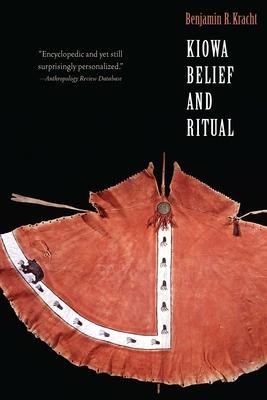Directed by anthropologist Alexander Lesser in 1935, the Santa Fe Laboratory of Anthropology sponsored a field school in southwestern Oklahoma that focused on the neighboring Kiowas. During two months, graduate students compiled more than 1,300 pages of single-spaced field notes derived from cross-interviewing thirty-five Kiowas. These eyewitness and first-generation reflections on the horse and buffalo days are undoubtedly the best materials available for reconstructing pre-reservation Kiowa beliefs and rituals. The field school compiled massive data resulting in a number of publications on this formerly nomadic Plains tribe, though the planned collaborative ethnographies never materialized. The extensive Kiowa field notes, which contain invaluable information, remained largely unpublished until now.
In Kiowa Belief and Ritual, Benjamin R. Kracht reconstructs Kiowa cosmology during the height of the horse and buffalo culture from field notes pertaining to cosmology, visions, shamans, sorcery, dream shields, tribal bundles, and the now-extinct Sun Dance ceremony. These topics are interpreted through the Kiowa concept of a power force permeating the universe. Additional data gleaned from the field notes of James Mooney and Alice Marriott enrich the narrative. Drawing on more than thirty years of field experiences, Kracht's discussion of how Indigenous notions of power are manifested today significantly enhances the existing literature concerning Plains religions.
Directed by anthropologist Alexander Lesser in 1935, the Santa Fe Laboratory of Anthropology sponsored a field school in southwestern Oklahoma that focused on the neighboring Kiowas. During two months, graduate students compiled more than 1,300 pages of single-spaced field notes derived from cross-interviewing thirty-five Kiowas. These eyewitness and first-generation reflections on the horse and buffalo days are undoubtedly the best materials available for reconstructing pre-reservation Kiowa beliefs and rituals. The field school compiled massive data resulting in a number of publications on this formerly nomadic Plains tribe, though the planned collaborative ethnographies never materialized. The extensive Kiowa field notes, which contain invaluable information, remained largely unpublished until now.
In Kiowa Belief and Ritual, Benjamin R. Kracht reconstructs Kiowa cosmology during the height of the horse and buffalo culture from field notes pertaining to cosmology, visions, shamans, sorcery, dream shields, tribal bundles, and the now-extinct Sun Dance ceremony. These topics are interpreted through the Kiowa concept of a power force permeating the universe. Additional data gleaned from the field notes of James Mooney and Alice Marriott enrich the narrative. Drawing on more than thirty years of field experiences, Kracht's discussion of how Indigenous notions of power are manifested today significantly enhances the existing literature concerning Plains religions.